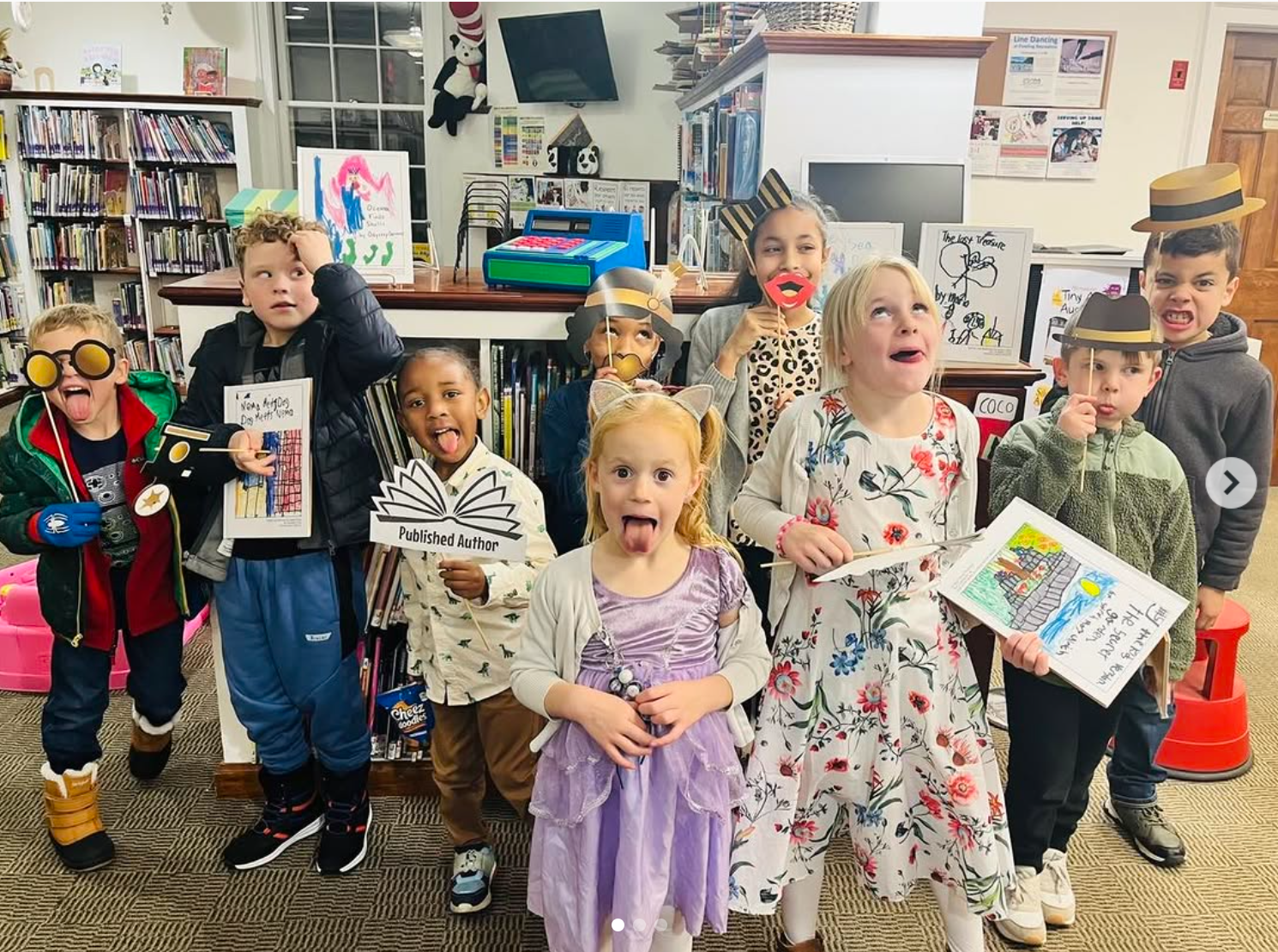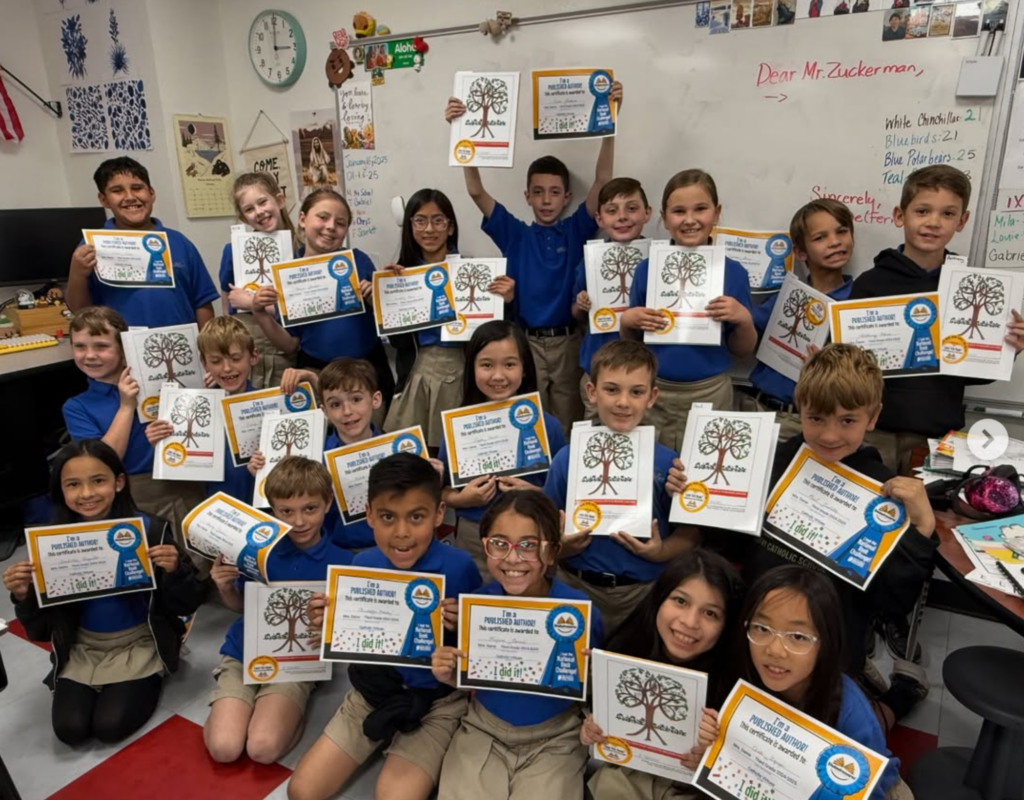As a teacher, you strive to give your students every tool and opportunity possible to learn, to grow, to push the limits of their imaginations, because you’re well aware of the incredible potential they possess. It is up to you to help them unlock it. As Malala Yousafzai once wrote, “One child, one teacher, one book, one pen can change the world.”
Guiding your class through the process of becoming published authors is a fantastic opportunity to help them realize their potential. After spending the last three decades publishing millions of books by young authors, we’ve seen some great classbook ideas come through, so we decided to compile some of our favorites into this list. These classbook ideas, combined with our quick “Tips for the Best Books” guide included below, will allow you to showcase your students’ best work in a way that will let individual talents and personalities shine. Short on time? Click here to see our full list of classbook ideas and sample books by grade level or topic.
#1: Asking an Unusual “What If?”
Many of the world’s greatest fiction began with two simple words: “What if?” What if a girl fell down a rabbit hole into another world? What if a boy planted a couple of magic beans? What if animals could talk?
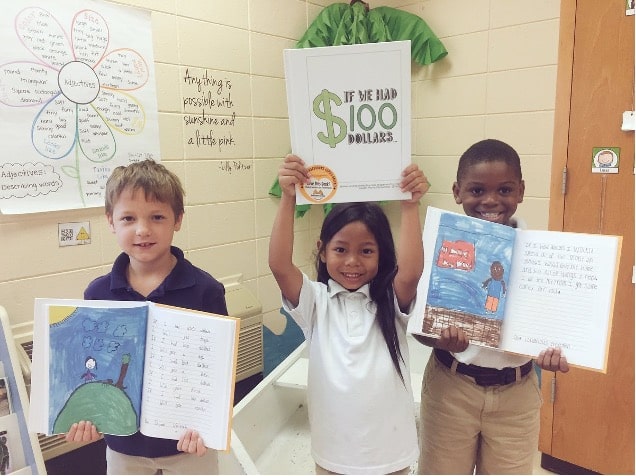
Miss Wriglesworth’s #ProudAuthors answer the question, “What if we had $100?”
Similarly, some of the best classbook ideas are the ones that ask students to consider not only how the world is, but how it might be. And of course, the stranger and more open to interpretation your question is, the deeper and more carefully your students will have to think about their answers. Some fantastic “what if” sample ideas to get you started might be:
What If All the Candy on the Planet Suddenly Disappeared?
Like many a great “what if,” this hypothetical question opens the door up to a number of follow-up questions and directions in which your students’ responses might go. Where did all the candy go? Who made it disappear, and why? How can we get it back? Do we even want it back?
What If Aliens Arrived on Earth, but They Were Invisible to People?
How would the aliens make contact with humans who could not see them? Would they try on Earth clothing to make themselves known or take advantage of the situation and take over the world quietly, while no one was looking?
What If I Found a Pair of Shoes That Could Take Me Anywhere?
This idea opens up a world of possibilities—several, in fact. Would your students go to another city, another country or another planet? How about another dimension? The best thing about this prompt is its flexibility—it can easily be tied into a science or geography lesson, or even history, if the shoes happen to travel through time!
The classbook This Was Once a Heart by Mrs. Coniker’s first-grade class at Ellenville Elementary School took subtle inspiration from a simple but effective “what if” question: “What if this heart became something else?” Each student took the shape of a heart and placed it in a different context. For one student, it became the head of a fire-breathing dragon; for another, it became the tip of a mermaid’s tail. No two were alike, and each had a different story to tell!
This Was Once a Heart by Mrs. Coniker’s class#2: Exploring Unique Viewpoints
Exploring alternate viewpoints is an extremely effective way to help your students build empathy for others while also improving their writing skills. It teaches them not just to think about what others may be feeling, but to imagine what it is like to be them and try to understand what they are going through and why they react the way they do.
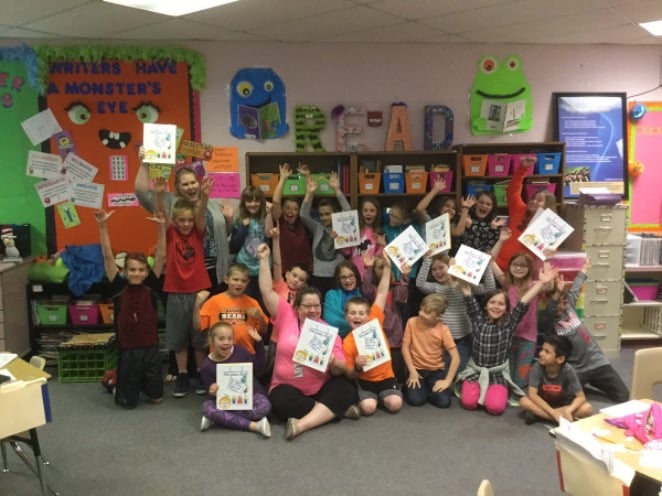
Mrs. Sanders’ #ProudAuthors jump for joy at the arrival of their finished classbook, When Teachers Attack: A True Story of Monsters & Minions.
It’s also an excellent base for a fun and creative classbook idea. Like “what if” prompts, projects that invite your students to imagine themselves as someone else—especially an unusual “someone,” or even a “something”—foster both their educational and emotional growth. Some especially unusual viewpoints you might consider include:
Imagining Life as a Holiday Mascot
What does Santa want for Christmas? What is the Easter Bunny’s favorite food? What is a pumpkin’s favorite thing to do during the day? This idea is great for getting into the spirit of whatever holiday season you are experiencing with a themed classbook—but you could also ask your students to research lesser-known mascots and holidays as an anthropology project instead.
School Employees Behind the Scenes
Have your students think about faculty and staff who play a big part in how the school functions. This could be the maintenance worker, the librarian or the crossing guard who helps everyone get across the street safely. What do they do during the day? Why do they do what they do? This idea is all about asking your students to notice the essential contributions those people make every day.
A Day in the Life of a Wild Animal
Spice up a science lesson with a creative writing assignment about the animals you’ve been studying! This idea can be as wild or as tame as you like—anything from “a day in the life of a walrus” to “what do sheep dream about?”
One imaginative student in Professor Maddox’s class at Liberty University School of Education wrote and illustrated a gorgeous example of this idea using a potted plant for a protagonist. Katherine Crist’s, A Case of the Prickles, on the surface, is about a cactus at odds with a group of flowers, but it is also about being yourself and choosing your words carefully.
One imaginative student in Professor Maddox’s class at Liberty University School of Education wrote and illustrated a gorgeous example of this idea using a potted plant for a protagonist. Katherine Crist’s, A Case of the Prickles, on the surface, is about a cactus at odds with a group of flowers, but it is also about being yourself and choosing your words carefully.
A Case of the Prickles by Katherine CristAre you Enjoying this Content?
#3: Encouraging Family Involvement
One of the beautiful things about classbook activities is how they bring students together. Watching your class learn to work together to achieve a shared goal is especially satisfying—as is celebrating together once the final published product arrives!
Making memories together is one of the best parts of a classbook project.
Classbooks also offer you the opportunity to invite your students’ families to become more involved in their education in a unique way. By asking your students to spend quality time with their families as part of their assignment, you’re encouraging more than a collaborative spirit—you’re helping them build stronger, deeper bonds through sharing experiences, while learning something new in the process. Try asking your students to:
Peek into the Past with Family Interviews
Interviews are fantastic classbook project ideas because they lend themselves so easily to so many different narratives. For a social studies project, students could ask their grandparents about their memory of a major historical event or ask their parents to talk to them about what they do for a living. Your students could even ask about themselves—what they were like as babies and toddlers—as research for a classbook collection of student autobiographies!
Memories That Make You Smile
Ask your students to discuss happy times they’ve spent with their loved ones, either their immediate family members or a beloved aunt, uncle or cousin—even a longtime best friend. Have them choose a favorite time to discuss, and ask them to write about how they remember it and how their loved one remembers it. Are their stories different, or do they both remember it the same way? Why did they choose it?
This idea is a fun way to relive some good times while learning about memory and can also be good practice for memoir-style writing. Bonus: Ask them to bring in copies of photos of them together with their loved one or have them draw the memory themselves! (Remember to send copies–original photos won’t be returned!)
Try Something New—Together
Instead of recalling old memories, ask your students to make new ones with their families by trying something new. Maybe it’s going somewhere they’ve never been or trying a new food they’ve never tasted. Ask your students to write about the experience in detail, including not just what happened, but how it made them feel and how their family felt about it.
This is a great exercise not only in descriptive writing but in exploring their own feelings—and taking those of their family members into consideration as well. Ask them to take pictures to include alongside their writing in their classbook!
One lovely example of this classbook idea in action comes from Providence Christian School students who created and published an interview-based project titled, What Was Your Life Like When You Were My Age? For this project, students talked to their grandparents about how life was different when they were younger. Then, they took their research and condensed it down to one-page summaries and drew illustrations depicting their grandparents’ youths. It’s a touching project, one that the students and their families will likely cherish for years to come.
What Was Your Life Like When You Were My Age? by Providence Christian School students#4: Reflecting on Classroom Memories
Of course, great memories aren’t just made at home—with a little help from you, your students can make plenty of them right in the classroom. Unlike at home, however, these moments are rarely recorded on home videos or in a parents’ loving photo album, and many get lost in time.
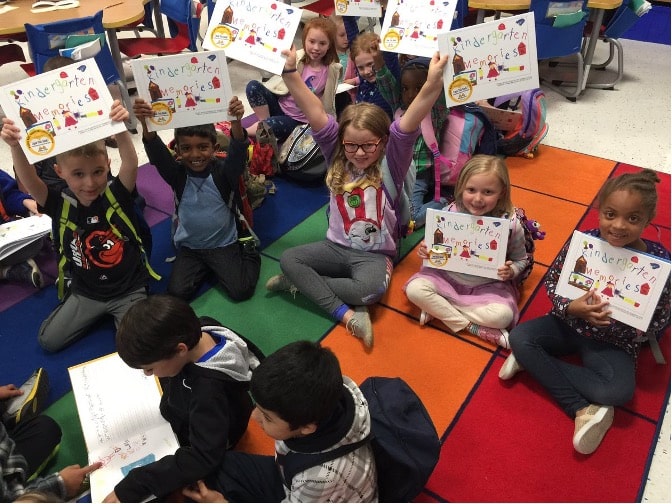
#ProudAuthors at Cooke Elementary celebrate the arrival of their Kindergarten Memories classbooks.
A scrapbook-style classbook might just be the perfect solution. This classbook idea accomplishes multiple goals at once by giving your students a means by which to explore their emotions, practice emotive writing and preserve precious classroom memories, all at the same time. Consider trying the following ideas:
Collaborative Scrapbooking
Instead of creating pages individually, try having your students team up in pairs or small groups, one group or team per page. Ask each group to choose one shared memory and have them each write about it separately. Then, ask them to work together to create colorful layouts and collages of photographs and drawings to match the memory they chose!
Comparative Journaling
Show your students how far they’ve come by asking them to select an old journal entry or other writing assignment to revisit, either by rewriting it or responding to it with more elaboration or describing whether their answer has changed and why. If possible, do the same thing with an old drawing and include both illustrations alongside both writing assignments for a neat “before and after” classbook!
Ms. Morales’ class at Wesley Matthews Elementary School put an interesting spin on this for their Book of Second Grade Memories. Instead of a regular scrapbook with one or two photos accompanying the text, they created full-page photo collages and matched them to third-person descriptions of each student in a beautiful class biography. Many included special messages for their classmates, such as one student’s touching note that “she loved her class family and wanted them to know they will always be part of [her] family.” (Our online bookmaker, Scripsi, might be an easier, more effective way to scrapbook! Check out the “Tips for the Best Book” section below for more information.)
Book of Second Grade Memories by Ms. Morales’ class#5: Thinking Outside the Books
The majority of classbook illustrations are created with a set of markers and blank sheets of paper. While there’s absolutely nothing wrong with this—in fact, bright, bold markers tend to print and show up the best in a published book—why not try something a little different? For teachers who have a little more time to make their students’ classbook stand out, here are some unique ways to illustrate their stories.
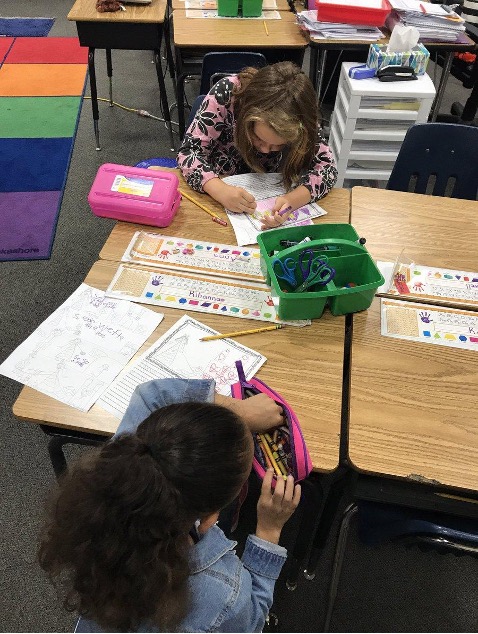
Future #ProudAuthors hard at work in a Del Mar Hills classroom.
Instead of simply asking your students to draw illustrations to accompany their writing, consider creating a project that will motivate your students to think outside of the box and experiment with new artistic mediums and techniques. Some examples include:
Character Masks
Writing about fictional or historical characters? Try asking your students to create masks of their famous figures’ faces. Take pictures of them wearing their masks to use as portraits for your book!
Sculptures
Using air-dry clay or a similar material, your students can create models of anything they can imagine, including models of wild new inventions or props from their stories. You can’t include their creations directly in your book, of course, but you can include color photos!
Chalk drawings
Chalk drawings on paper may not print well, but what about good old sidewalk sketching? With permission from your school administrators, take your students out for some fresh air and outline a paved spot on the school grounds. Ask them to fill it with colorful chalk drawings to be photographed for use in your project!
One of the best examples of putting this classbook idea into action comes from Mrs. Hick’s at McClellan Grade School. For their classbook, Our ABC Book, the students used their entire bodies for their illustrations by getting into different poses together to form each letter in the alphabet. They even used the letters they formed to spell out the title on the cover of the book!
Our ABC Book by Mrs. Hick’s ClassExplore More Classbook Topic Ideas
Looking for more classbook topic ideas? See our sample classbooks for inspiration.
- Alphabet Classbooks
- Animal Classbooks
- Creative Writing Classbooks
- Foreign Language Classbooks
- Poetry Classbooks
Click here to see all sample classbooks by topic!
Tips for the Best Classbook
Ready to start your classbook? Here are a few general best practices to follow during the publishing process:
- Practice makes perfect: Even the best writers write more than one draft, and even the most talented artists keep a few erasers handy. Before asking your students to write and draw on the final template pages that will be sent in, allow them to try their ideas out on some practice sheets first.
- Brighter is better: While you probably want to avoid garish, clashing color schemes, as a general rule of thumb bright, bold colors and high contrast tend to print better than softer, subtler tones. Similarly, pen or marker are always much easier to see than pencil.
- If you can’t replace it, don’t send it: Never send original photos, artwork or any other precious items that cannot be replaced or duplicated—they won’t be sent back, and there’s always the minor chance of damage during shipping. Always make copies, either digitally or by hand, of anything you or your students wouldn’t want to lose. When attaching artwork or photos to pages, use a glue stick.
- Got a lot of photos? Consider going digital: Scanning pictures can be time-consuming and can result in slightly faded images in the final product. If your project relies heavily on photographs, consider using our online bookmaker, Scripsi, rather than a physical kit, and upload digital photos directly to your project to preserve their quality and colors.
- Keep students engaged every step of the way: Creating a classbook is a rare opportunity for kids to get a sneak peek inside the wonderful world of publishing—don’t waste that chance by shutting them out of the process! Even something as simple as asking for opinions and brainstorming topic ideas together will help them feel involved and that their input matters.
- Set a reasonable timeline: There’s nothing worse than having to rush something that should be completed with care and consideration—especially something as precious as a classbook. When you set a publishing date, be sure to leave your class adequate time for each step in the creation process, along with a little buffer room for unexpected setbacks. That being said, if you do misjudge your timeline, don’t panic! Instead, you can update your publishing date within the Publishing Portal.
Classbooks as Creative Opportunities
A classbook is a very special kind of activity. It teaches students about writing and publishing, but along the way they also learn more intangible skills like resourcefulness, cooperation and critical thinking. By publishing your class’ work, you help build motivation, confidence and make even the brightest futures shine just a little bit brighter.
Whether you’re starting with a physical draft using templates for your publishing kit or organizing your project digitally using our online bookmaker, creating a classbook is easier and more time-efficient than ever. Before you know it, your students will be holding their professionally published classbooks in their hands and joyfully congratulating one another on becoming proud young authors.
For a wealth of FREE teaching resources including lesson plans, classbook topic ideas and more, visit our online teacher’s lounge and order your FREE publishing kit!






